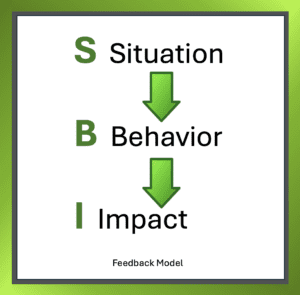The SBI Model: A Powerful Framework for Delivering Effective Feedback
Effective feedback is essential for growth and development in any workplace. One structured approach that has gained recognition for its clarity and effectiveness is the Situation-Behaviour-Impact SBI Model.
This framework provides a straightforward way to deliver feedback that is specific, actionable, and focused on observable behaviours rather than assumptions.
Understanding the SBI Model
Developed by the Centre for Creative Leadership, the SBI Model offers a three-part structure that helps managers and colleagues deliver feedback in a way that is both clear and constructive. The model breaks down feedback into three essential components:
1.Situation
The first step is to establish the context by describing the specific situation where the behaviour occurred. This creates a clear reference point and helps the recipient understand exactly what instance you’re addressing.
For example:
- “During yesterday’s client presentation…”
- “At our team meeting last Thursday…”
- “While handling the customer complaint on Tuesday morning…”
By being specific about when and where the behaviour occurred, you avoid vague generalities that can feel like personal attacks.
- Behaviour
The second component focuses strictly on describing the observable behaviours, what the person actually did or said. This is where many feedback conversations go wrong, as people tend to insert assumptions, judgments, or interpretations rather than sticking to observable facts.
The key is to describe the behaviour objectively, as if you were watching it on video:
- “You arrived 15 minutes late and didn’t have your materials prepared.”
- “You responded to each question thoroughly and provided supporting data.”
- “You interrupted Sarah three times during her presentation.”
By focusing on specific behaviours rather than making character judgments, you create a foundation for constructive conversation.
- Impact
The final component describes the effect or consequence of the behaviour, how it influenced you, the team, clients, or the organisation. This helps the recipient understand why the behaviour matters.
Examples include:
- “This caused the client to question our preparedness and may have damaged our credibility.”
- “As a result, the team was able to make an informed decision quickly.”
- “This made Sarah appear less knowledgeable and undermined team cohesion.”
Using “I” statements when describing impact “I felt…” or “I was concerned that…” can be particularly effective as it focuses on your authentic experience rather than making sweeping claims about how everyone felt.
Why the SBI Model Works
The SBI Model’s effectiveness stems from several key strengths:
- It’s specific: By focusing on particular situations and behaviours, it avoids generalisations that can feel like personal attacks.
- It’s objective: The model emphasises observable behaviours rather than assumptions about intentions or character.
- It connects actions to outcomes: By explaining the impact, it helps people understand why their behaviour matters.
- It provides clarity: Recipients understand exactly what behaviour is being addressed and why it’s important.
- It creates psychological safety: The structured, non-judgmental approach reduces defensiveness.
Practical Application Tips
To maximize the effectiveness of the SBI Model:
- Prepare in advance: Jot down notes for each component before delivering feedback.
- Balance positive and constructive feedback: Use the model to reinforce positive behaviours as well as address areas for improvement.
- Be timely: Deliver feedback as soon as reasonably possible after observing the behaviour.
- Create dialogue: After delivering SBI feedback, ask open questions to understand the other person’s perspective.
- Focus on future action: Conclude by discussing what should be continued or changed going forward.
Limitations to Consider
While powerful, the SBI Model does have some limitations:
- It may feel formulaic if used too rigidly
- Cultural differences can affect how feedback is received
- Complex situations might require additional context
- The model focuses on observed behaviour, which may miss underlying issues
Conclusion
The SBI Model provides a clear structure for delivering effective feedback that minimises defensiveness and maximises understanding. By focusing on specific situations, observable behaviours, and their tangible impacts, you create feedback conversations that lead to genuine insight and positive change.
Whether you’re addressing performance concerns or reinforcing excellent work, this straightforward framework helps ensure your message is received as intended.
When implemented thoughtfully, the SBI Model transforms feedback from a dreaded experience into a valuable opportunity for growth and development, benefiting both individuals and organisations.

